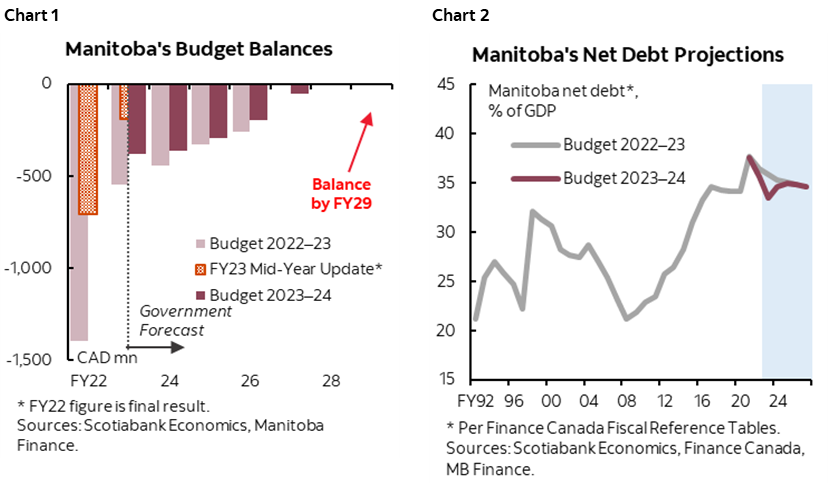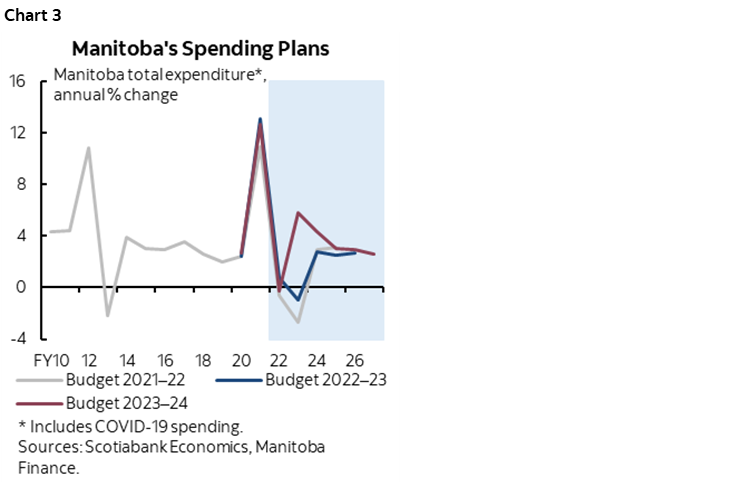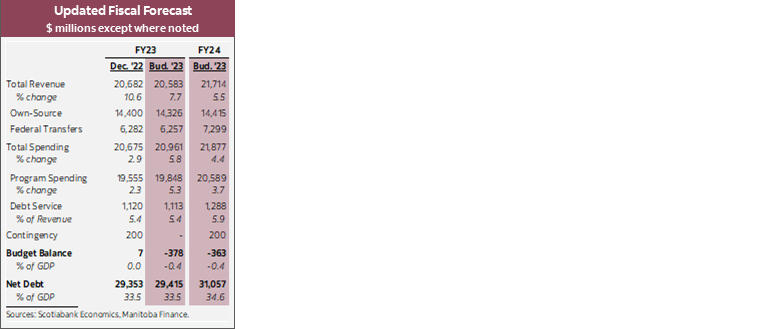MODEST DEFICITS EXPECTED WITH MORE TAX CUTS AND PRIORITY SPENDING
- Budget balance forecasts: -$378 mn (-0.4% of nominal GDP) in FY23, -$363 mn (-0.4%) in FY24, and -$294 mn (-0.3%) in FY25; return to balance targeted for FY29 (chart 1).
- Net debt: expected to edge up from 33.5% in FY23 to 34.6% in FY24 before peaking at 35.0% in FY25 (chart 2)—reflecting slower nominal growth combined with increased capital outlays.
- Real GDP growth forecasts: +3.6% in 2022, +0.7% in 2023, and +1.1% in 2024—2023 growth revised significantly lower versus the last budget (+2.8%).
- Borrowing requirements: $4.7 bn in FY24, of which $2.4 bn comes from refinancing. New borrowings are expected to average $1.7 bn during FY25–27, while refinancing will average $3.4 bn per year over the same period.
- Underpinned by reasonably conservative assumptions, Manitoba’s pre-election Budget 2023 largely contains new spending increases to health care—offset by the newly announced support from the federal-provincial agreement—along with modest changes to personal income tax relief measures.

OUR TAKE
In Budget 2023, Manitoba’s fiscal position is set to improve gradually in the medium-term with a string of shrinking deficits through FY27. The deficit in FY24 is projected at -$363 mn (-0.4% of nominal GDP)—virtually flat from the FY23 deficit now estimated at -$378 mn. Budget 2023 projects a slightly improved fiscal path than in the last budget with narrower deficits through FY24-26 as the province expects higher federal transfers, partially offset by a near-term spending boost. The province continues to anticipate a balanced budget by FY29. Net debt-to-GDP ratio is expected to edge up from 33.5% in FY23 to 34.6% in FY24, before peaking in FY24 at 35% and remaining elevated through the planning horizon—consistent with increased capital spending outlays and slower nominal growth assumptions.
Revenues are forecast to rise by 5.5% in FY24 (before contingency), reflecting enhanced federal transfers from equalization and the new healthcare funding. Manitoba anticipates $5.9 bn in major transfers in FY24—up 14.2% over FY23—and 60% of which will come from equalization payments. Own-source revenues are expected to remain flat from FY23, with increases in personal and corporate income offset by the fiscal impact of new tax relief measures. Over the medium term, total revenue is set to grow at an average pace of 3.1% through FY27.
Released before the provincial election in October, the budget contains tax relief measures helping with rising cost of living. Manitoba aims to improve its tax competitiveness, raising the Basic Personal Amount to $15,000 at a fiscal cost of -$311 mn, along with an increase in tax bracket thresholds to $47,000 and $100,000 in 2024 with a -$40 mn impact in revenues. To assist small businesses, the province also plans to reduce the Health and Post-Secondary Education Tax Levy rate based on fiscal performance.
The province plans to ramp up program spending in priority areas like health care and community safety, but keeps the pace within the bounds of revenue growth (chart 3). Total spending is slated to rise by 4.4% in FY24, following a 5.8% growth in FY23. With additional funding support from the federal government, the province is boosting healthcare expenses by $668 mn (0.7% of GDP) in FY24—the equivalence of a 9.2% increase—accounting for about 90% of program spending increases. Other major new spending includes over $100 mn designated to strengthen community safety over two years, as well as an additional $92.5 mn to support the education system. Over the medium term, total spending will continue to grow at an average pace of 2.8% per year, in line with the pace of revenue growth. Debt service costs are expected to be $88 mn higher than in last budget, accounting for 5.9% of total revenue in FY24, up from 5.4% in FY23.

Acknowledging the challenges in forecasting, economic projections underpinning the Budget appear characteristically cautious. With real GDP growth assumed at 0.7% this year and 1.1% next year—both lower than our current projections at 1.4% and 1.6%—the Budget accounts for some downside risks in growth, while a recession is not in the baseline. Abundant contingencies are built into the fiscal plan with a $200 bn contingency pencilled in for FY24, which gradually declines over the next three fiscal years.
Manitoba extended its capital plan horizon from three years to five years, dedicating an average of $2.8 bn each year over the next five years in infrastructure investment—in line with last budget’s plan. The total price tag for infrastructure investment over the next 5 years comes out to $14.0 bn, of which $4.5 bn will consist of buildings, equipment and technology, and $3.3 bn will go towards the maintenance and construction of roads, highways, bridges and flood protection.
Manitoba’s borrowing requirements total $4.7 bn in FY24. Of this amount, $2.4 bn will be allocated towards refinancing purposes in FY24, and $2.1 bn will be pre-funding for FY25. As of the time of the budget release, approximately $1.8 bn of funding for FY24 had been pre-borrowed. Borrowing requirements are expected to increase to $5.3 bn in FY25 and $5.7 bn in FY26, before decreasing to $4.4 bn in FY27, with new cash decreasing from $1.9 bn down to $1.4 bn over those three years.

DISCLAIMER
This report has been prepared by Scotiabank Economics as a resource for the clients of Scotiabank. Opinions, estimates and projections contained herein are our own as of the date hereof and are subject to change without notice. The information and opinions contained herein have been compiled or arrived at from sources believed reliable but no representation or warranty, express or implied, is made as to their accuracy or completeness. Neither Scotiabank nor any of its officers, directors, partners, employees or affiliates accepts any liability whatsoever for any direct or consequential loss arising from any use of this report or its contents.
These reports are provided to you for informational purposes only. This report is not, and is not constructed as, an offer to sell or solicitation of any offer to buy any financial instrument, nor shall this report be construed as an opinion as to whether you should enter into any swap or trading strategy involving a swap or any other transaction. The information contained in this report is not intended to be, and does not constitute, a recommendation of a swap or trading strategy involving a swap within the meaning of U.S. Commodity Futures Trading Commission Regulation 23.434 and Appendix A thereto. This material is not intended to be individually tailored to your needs or characteristics and should not be viewed as a “call to action” or suggestion that you enter into a swap or trading strategy involving a swap or any other transaction. Scotiabank may engage in transactions in a manner inconsistent with the views discussed this report and may have positions, or be in the process of acquiring or disposing of positions, referred to in this report.
Scotiabank, its affiliates and any of their respective officers, directors and employees may from time to time take positions in currencies, act as managers, co-managers or underwriters of a public offering or act as principals or agents, deal in, own or act as market makers or advisors, brokers or commercial and/or investment bankers in relation to securities or related derivatives. As a result of these actions, Scotiabank may receive remuneration. All Scotiabank products and services are subject to the terms of applicable agreements and local regulations. Officers, directors and employees of Scotiabank and its affiliates may serve as directors of corporations.
Any securities discussed in this report may not be suitable for all investors. Scotiabank recommends that investors independently evaluate any issuer and security discussed in this report, and consult with any advisors they deem necessary prior to making any investment.
This report and all information, opinions and conclusions contained in it are protected by copyright. This information may not be reproduced without the prior express written consent of Scotiabank.
™ Trademark of The Bank of Nova Scotia. Used under license, where applicable.
Scotiabank, together with “Global Banking and Markets”, is a marketing name for the global corporate and investment banking and capital markets businesses of The Bank of Nova Scotia and certain of its affiliates in the countries where they operate, including; Scotiabank Europe plc; Scotiabank (Ireland) Designated Activity Company; Scotiabank Inverlat S.A., Institución de Banca Múltiple, Grupo Financiero Scotiabank Inverlat, Scotia Inverlat Casa de Bolsa, S.A. de C.V., Grupo Financiero Scotiabank Inverlat, Scotia Inverlat Derivados S.A. de C.V. – all members of the Scotiabank group and authorized users of the Scotiabank mark. The Bank of Nova Scotia is incorporated in Canada with limited liability and is authorised and regulated by the Office of the Superintendent of Financial Institutions Canada. The Bank of Nova Scotia is authorized by the UK Prudential Regulation Authority and is subject to regulation by the UK Financial Conduct Authority and limited regulation by the UK Prudential Regulation Authority. Details about the extent of The Bank of Nova Scotia's regulation by the UK Prudential Regulation Authority are available from us on request. Scotiabank Europe plc is authorized by the UK Prudential Regulation Authority and regulated by the UK Financial Conduct Authority and the UK Prudential Regulation Authority.
Scotiabank Inverlat, S.A., Scotia Inverlat Casa de Bolsa, S.A. de C.V, Grupo Financiero Scotiabank Inverlat, and Scotia Inverlat Derivados, S.A. de C.V., are each authorized and regulated by the Mexican financial authorities.
Not all products and services are offered in all jurisdictions. Services described are available in jurisdictions where permitted by law.

